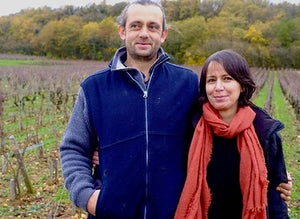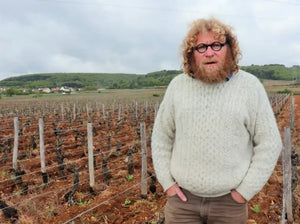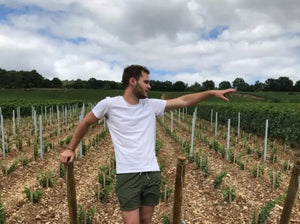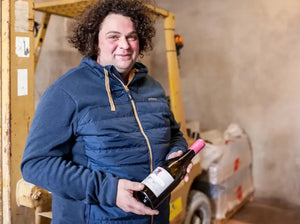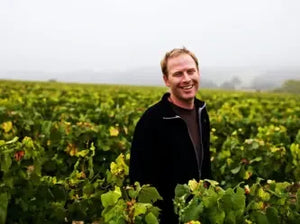Blog » Burgundy
-
Morey-Saint-Denis Icon: Hubert Lignier
Hubert Lignier is benchmark Morey Saint Denis, and one of Burgundy's most hallowed domaines. Over the last decade, Laurent Lignier has brought the domaine back to the heights of times past, under his father, where it was among the single most revered names in the Côte de Nuits. Always darker than the neighboring village of Chambolle-Musigny, the Morey wines from Lignier now show added lift and key freshness that have made them the envy of collectors throughout this new renaissance of late.
Lignier has been imported by Neal Rosenthal since the 1978 vintage, marking one of Neal's earliest and greatest successes. The style of the domaine has always been one that emphasized structure and distinct terroir-driven soil expression. Lignier's wines display the prototypical Morey rusted earth, black cherry, and a telltale hoisin note that the village is often associated with. However, as I mentioned, the style has recently shifted toward emphasizing the brightness of fruit and freshness as the foundation. -
Florence Cholet: Burgundy's Best Kept SecretFlorence Cholet's under the radar wines
-
Bitouzet-Prieur: Classicism Holding Steady
We all have regrets. One of mine was passing on Bitouzet-Prieur Volnay and Meursault when I turned on the lights in 2015. A friend once said, “If you’re not embarrassed by choices made in the previous year, then you’re not growing.” The 2020 vintage of this domaine marks my redemption.
With winemaking medals galore filling the home of Vincent Bitouzet back in 1860, the marriage to Annie Prieur after that marked the official start of what is now the most classic domaine in Volnay, along with Lafarge. And the whites from vineyards like Meursault 1er Cru Charmes and Perrières are now another great reminder that value is alive and well in the Côte de Beaune.
I only have a few wines from Bitouzet-Prieur, but they are the best cuvées to me after an extensive tasting with the domaine in Brooklyn last year. The Volnay is destemmed, and pigeage (punchdowns) occur twice per day—a process that has seemingly gone out of fashion in Burgundy of late as many opt for remontage (pumpovers) to bring softer contours and more immediacy to the fruit. But the 2020 Volnay is pure class and is precisely the type of Burgundy I seek out—from the greatest red village of the Côte de Beaune.
The whites see extended lees contact and a maximum of 20% new oak. They pull back on the fruity Chardonnay traits, instead digging deep for a saturating mineral through-line that reminds me of wines common pre-2005 heat. Still bursting with site-specificity and deliciousness, they take my mind back to another time with their soft-spoken spirit. -
Delectable Dijon: Domaine de la Cras
In the hills above Dijon, you can find one of Burgundy's greatest inception stories. It is a fresh departure from a domaine's normal evolution, but the wines in bottle are the most thrilling element from Marc Soyard. In a short time, Domaine de la Cras has gone from obscure to having a cult following.
A little over a decade ago, the city of Dijon purchased a vineyard just outside its limits, and they essentially held a casting call to find a winemaker for the property. The criteria were: The winemaker must be young, have no family vineyard holdings, farm organically, and open the domaine for educational tours. Rent for the land would be paid to the city in 2,000 bottles. Marc Soyard, originally from nearby Jura, was chosen.
Soyard does not come from a family of vignerons but previously worked for Vosne-Romanée's esteemed Domaine Bizot, known for its rigorous vineyard work, minuscule sulfur regimen, and whole-cluster fermentation. Soyard's Pinot Noirs pulled me in for their super crunchy and unadulterated bright, red berry fruit. The aromas are intoxicating even before tasting, and whole-cluster fermentation gives these wines a lifted spice and floral character that just floored me.
His Chardonnay's offer a totally unique take on white Burgundy, coming from this long-overlooked terroir––seamless and classic.
"Cras" Rouge & Blanc are the domaine's top wines from the oldest vines on the steepest portion of En Bessy.
Coteaux de Dijon Rouge & Blanc comes from 30-plus-year-old vines planted lower on the slope, with the rouge seeing 30% whole clusters being included for fermentation in wooden tanks without any sulfur additions.
Tercet is Soyard's lone Gamay––an upfront fruity style with imperceptible tannins.
-
Zero Fluff, All Focus: Jouan Morey 1er Cru Clos Sorbé
I'm often asked which Burgundy domaines should be on the radar for their classic character and no frills personality. The name atop that list, embodying both, is Philippe & Henri Jouan of Morey-Saint-Denis. Their greatest wine from their home village is the Premier Cru Clos Sorbé. The late, great Jacky Truchot once made this vineyard legendary, with bottles now fetching upwards of $2,000. When he retired (sort of) in 2005, he sold all his vineyards—except for Clos Sorbé, as he continued producing a tiny amount from a backyard site he cherished.
Today, Jouan carries the torch, crafting wines of incredible finesse with old-school sensibilities. And unlike Truchot’s now-mythic bottling, entry into this piece of Burgundy history is under $200.
Morey is often defined by what it isn't—neither Gevrey-Chambertin to the north nor Chambolle-Musigny to the south. Its wines trade Chambolle’s red cherry for darker berries, layered with forest floor and brown and rust-tinged earthy notes. And, unlike Gevrey’s muscular structure, Morey retains a grace and lift that always brings me back to a more Chambolle ethos of refinement.
Clos Sorbé centers around the same dark cherry fruit profile, but adding notes of orange rind, cocoa, and smoked game. All wrapped up with great acidity, fine-grained tannin, and unmistakable Premier Cru length and drive. While very structured in its extreme youth, with a few years in bottle, like today's 2020, these expressions are in full blossom.
-
Burgundy's New Wave: Domaine DidonDavid and Naima Didon are today's most exciting examples of Burgundy's new generation. Coming to fruition in 2017, they have wowed us with their fresh and seamless wines crafted amid increasingly warming global temperatures, where these two traits are more elusive than ever. The inception story starts at an old farm in Chassey-le-Camp in Côte Chalonnaise, in Bouzeron––the only village whose legal status belongs solely to Aligoté. David is a veteran viticulturist, and after spending ten years consulting for Etienne De Montille in Volnay and time in the cellar with Julien Altaber, Domaine Didon was formed.David and Naima's two-hectare domaine relies on organic and biodynamic farming for Pinot Noir, Pinot Blanc, Chardonnay, and Aligoté. Their unique setting features dense yellow limestone on an east-facing slope, historically renowned as the best terroir in the village. Farming is done by horse and hand, without the use of tractors or heavy machinery, preventing soils from becoming overly compressed.They choose a hands-off approach in the cellar while still respecting and embracing new and alternative techniques. Whites are all whole bunch pressed, and the reds see a short 10-day maceration on skins. Wines are fermented in a mixture of vessels, including amphora, barrels, and fiberglass. All wines spend about a year on lees before bottling and remain unsulfured whenever possible. Like the best wines from this natural protocol, you don't consider them natural when you taste them. It's only their intrinsic connection to the fruit on the vine, with finesse and freshness, that captures the best qualities of everything natural wine done correctly.
-
Designations be Damned: Sylvain Pataille Marsannay
Sylvain Pataille is famous for three things: Producing some of the most texturally seamless and balanced wines in the Côte de Nuits, his oenologist consulting for over 15 domaines, and having really awesome hair. My visit to the domaine was a terroir masterclass, as we tasted over 20 wines from Marsannay.
Marsannay and Pataille are a match made in heaven. Both have seemingly flown under the radar for far too long. Search through any savvy Burgundy collector's cellar, and next to the Rousseau and Dujac, you're sure to find a host of Pataille's Marsannay. This village located above Gevrey Chambertin has a complicated history, though. Mainly planted with Gamay at the time of classifications, no vineyards could receive a status higher than villages.
Today, Clos du Roy would undoubtedly be a Premier Cru, and it's a steal within the hierarchy of Burgundy's elite. There's never shyness here, always finding that elusive mix between power, elegance, and silken tannins without overt new oak influence. And, believe it or not, Le Chaptire's historical pricing in the 16th century was only surpassed by Chambertin-Clos de Beze. It's still among the ultimate insider lieu-dits and an equally worthy cellar mate with Clos du Roy. -
Leaping Over Legacy: Pierre Girardin Bourgogne
Vincent Girardin's name was synonymous with Burgundy's breadth, with wines coming from enviable vineyards throughout the Côte d'Or. Although the vast terroir had undeniable gems from Grand Crus and Premier Crus, the large production made for boring wines. When Vincent sold the domaine in 2011, he kept 4.5 hectares of the top holdings for his son, Pierre. After spending time in the vines, cuverie, and cellar from a very young age, the 21-year-old Pierre wanted to take a different philosophical path with his label. He was determined to be associated with the highest quality work––albeit with much more limited availability.
As the cuvée's label suggests, calcaire (limestone) is what Pierre wants to express, and the lens of terroir is in focus with these terrific Bourgogne wines. Pierre's methods highlight freshness and finesse––a rare move was selecting considerably larger 456L barrels for aging and favoring punchovers (as opposed to punchdowns) for the reds to keep their tannins silken. The value proposition in Burgundy is one that we bring up a lot. No doubt, pricing keeps climbing, but the emergence of new values is always around the corner. Pierre Girardin is a name that delivers in a big way with a relatively low price tag, given the quality and terroir. -
Burgundy Fireworks: Yann Charlopin-Tissier
A June 2016 visit in Burgundy meant tastings with some of my favorite storied domaines like Mugneret-Gibourg and Denis Bachelet, but it was after a lunch with Jeremy Seysses at Domaine Dujac and a beautiful bottle of 1993 Clos de la Roche that I got tipped off to something happening across the street—the new Domaine Charlopin-Tissier.
Yann Charlopin-Tissier’s background is surrounded by legendary figures. His father, Philippe Charlopin, was a student of Henri Jayer as he started his own domaine in 1978. Yann worked closely with his father starting in 2004, and then with another mentor, Jean-Marie Fourrier, before launching his own domaine, now at just 4 hectares. Like these Vosne-Romanée and Gevrey Chambertin mythic names, Yann favors picking as ripe as possible and prefers de-stemming.
Yann filled me in on his methodical and organic approach to viticulture, his excruciatingly low yields, and his disdain for talking too much about winemaking choices in the cuverie. "These wines are made in the vineyard," he would repeat. And the dirt under his nails, and muddy boot prints littered throughout the courtyard drove home that point. For me, this image greatly juxtaposed with what you find in bottle––suave and sophisticated texture, luxurious mouthfeel, supported by very concentrated ripe fruit buffered with mouth-watering salinity.
My two favorite wines of the 2020 vintage capture precisely what is so special here: The Marsannay La Montagne is surely the sleeper pick in the range, but this lieu-dit coming from the top of the slope in Marsannay where it is substantially rockier than below offers a masterclass in balance, between bold, ripe, dark fruit with powdery tannins and mineral finish. The Pernand Vergelesses Sous Frétille is one of best kept secrets in Premier Cru white Burgundy. Always a site that delivers crisp salinity and a Grand Cru-level drama. Yann’s version has a ruthless intensity of fruit with a chalky grip that is truly head-turning. This reflects his ambition for powerfully concentrated wines that still somehow have a wizardly refinement on the palate. -
Chablis King in Waiting: Patrick Piuze
It's overwhelmingly agreed that Raveneau and Dauvissat represent the most crowning achievements in Chablis, but Patrick Piuze is a king-in-waiting. Piuze is a wizard at working with stainless steel and oak to craft Chardonnay from Chablis' fossilized ancient sea bed that delivers the grandeur expected from these top vineyards. Like Raveneau and Dauvissat, it's the regal structure, seamless contours, and definitive cut married to this breadth that places Piuze in elite company.
Wine critic William Kelley on the vintage:
"2020 is another excellent vintage at this address, and even if the two years were very different on paper, it might be compared to a more extroverted, open-knit version of the superb 2017 vintage at this address... The resulting wines are elegantly textural but incisive, clearly differentiated by site. This is also the best address to explore the village-level Chablis AOC, as Piuze produces a number of cuvées and lieu-dit bottlings designed to highlight the diversity that this large appellation encompasses."
.svg?v=162776257677185172071724397232)








